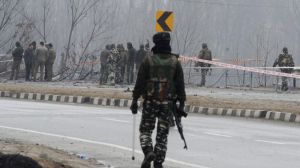Study says stubble burning in Punjab a ‘marketing system failure’, not defiance
In the light of this, an academic study, Governmentality and Marketing System Failure: The Case of Stubble Burning and Climate Change in Neoliberal India, however cautioned against the penalisation of farmers.
 The research contends that stubble burning is the direct outcome of India’s agricultural marketing structure — shaped by state policies, market forces and farmers’ marginalisation — rather than a mere ecological lapse. (Express Archives)
The research contends that stubble burning is the direct outcome of India’s agricultural marketing structure — shaped by state policies, market forces and farmers’ marginalisation — rather than a mere ecological lapse. (Express Archives)Hearing petitions about stubble burning linked to air pollution in Delhi-NCR, the Supreme Court on Wednesday suggested the government send “some” farmers to jail to curb the menace — which, it said, could act as a deterrent.
In the light of this, an academic study, Governmentality and Marketing System Failure: The Case of Stubble Burning and Climate Change in Neoliberal India, however cautioned against the penalisation of farmers.
The study is authored by Sujit Raghunathrao Jagadale, Professor of Rural Marketing at the Indian Institute of Management (IIM-Amritsar), and Javed M Shaikh, then IIM post-doctoral researcher working with Jagadale.
The study, spanning from 2022 to 2024, was published in the Journal of Macromarketing (a US-based journal) in March this year.
The study argues that blaming or criminalising farmers alone will fail to curb the menace unless structural reforms address the economic and social realities on the ground. It argues that this practice is less about individual choices and more about systemic failures.
“Rather than viewing themselves as partners in a co-evolving agricultural system, farmers increasingly perceive themselves as victims of exploitative exchange processes,” the authors said.
The study also highlights how governmentality and India’s Minimum Support Price (MSP) system, along with procurement by the Food Corporation of India (FCI), have locked farmers in Punjab and Haryana into a wheat–rice cycle.
MSP, while protecting farmers from market fluctuations, discourages crop diversification, leaving little room for alternatives to rice cultivation, the study says.
The research contends that stubble burning is the direct outcome of India’s agricultural marketing structure — shaped by state policies, market forces and farmers’ marginalisation — rather than a mere ecological lapse.
“Stubble burning is not an act of defiance but the outcome of distorted governmentality (the government uses indirect ways… to make people control their own behaviour),” Jagadale told The Indian Express. “The study — based on in-depth interviews with farmers, middlemen and local stakeholders in Punjab’s Tarn Taran, Amritsar and Gurdaspur districts — concludes that crop residue burning is less about willful disregard and more a consequence of policy distortions, exploitative market structures, and farmer precarity,” he said.
The authors argued that in distorted governmentality the state policies — designed to regulate and support agriculture — end up disciplining farmers into unsustainable practices. By focusing narrowly on procurement targets and MSP, the government has created a system where farmers are compelled to produce only wheat and paddy in fixed cycles, with little space for diversification or innovation.”
The study said, “Around 25 per cent of India’s crop residue is burnt, releasing black carbon and greenhouse gases… With just a short window between harvesting paddy and sowing wheat, farmers see burning crop residue as the cheapest and fastest option. Alternatives like using stubble as fodder or processing it into pellets are costly and time-consuming.”
It also said that small and marginal farmers (up to five acres) are comparatively vulnerable, lacking agency, resources and access to sustainable waste management technologies.
“They operate in what the study calls a ‘marginalised majority’, facing debt, insecurity and low living standards,” the study says, adding that low-cost practices like stubble burning is a consequence of their limited choices.
The state has left burning as the “cheapest and fastest” option for farmers who must clear fields quickly for the next sowing by failing to build an ecosystem that creates value out of crop residue — whether as cattle feed, biofuel, or raw material for industry.
The study also highlights the entrenched role of arhtiyas (commission agents), who not only mediate crop sales but also act as informal moneylenders. Their dual role, often at high interest rates. “These socially embedded relationships can dispossess farmers at will,” the study notes, adding that structural inequality deepens the resort to stubble burning.
Chronic indebtedness, rising household costs, shrinking state support and fragmented landholdings together create what they call a “perfect storm of precarity”.
The study recommends multi-pronged reforms including creating markets for stubble-based products (fodder, pellets, packaging, textiles); providing assured prices for stubble, incentivize industries to use stubble-based products; ensuring fair price transparency; making subsidised machinery available to farmers at the affordable price; building apps linking farmers to stubble buyers, energy and fodder plants; and providing cash support for stubble transport, crop diversification assistance, and stronger welfare integration.
The paper also calls for a shift in cultural aspirations that fuel household debt, noting that consumerism and rising social expenses add pressure to unsustainable farming practices.
“Stubble burning is not indiscipline — it is a reflection of how policies and markets corner farmers into decisions that harm both them and society,” the authors said.







